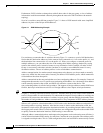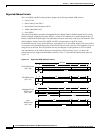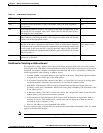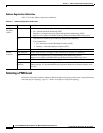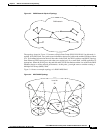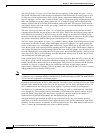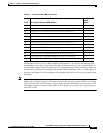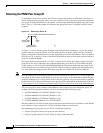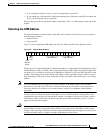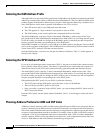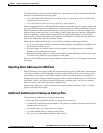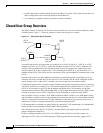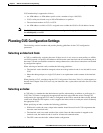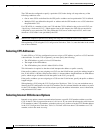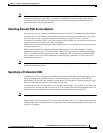
3-10
Cisco PNNI Network Planning Guide for MGX and SES Products, Release 5
Part Number OL-3847-01 Rev. D0, April, 2004
Chapter 3 Address and Closed User Group Planning
Planning Address Configuration Settings
Selecting the PNNI Peer Group ID
As described in the previous section, the PNNI level selects the number of ATM address bits that are
unique within the peer group ID. After you select a PNNI level for a peer group, you need to define the
peer group ID using the PNNI level, the number of address bits defined by the PNNI level, and trailing
zeros. Figure 3-5 shows the format of the default peer group ID for the Cisco MGX and SES switch
products.
Figure 3-5 Default Peer Group ID
As Figure 3-5 shows, the peer group ID begins with the PNNI level, followed by a colon. The unique
portion of the peer group ID follows next. The unique portion of the ID, which is the first 7 bytes by
default, corresponds with the left-most or most-significant bytes of the ATM address. The Cisco default
PNNI level is 56, so the first 7 bytes of the default ATM address make up the unique portion of the peer
group ID: 47.009181000000.
The total length of a peer group ID is 14 bytes, so the bytes that follow the unique portion of the peer
group ID are all set to 0. Therefore, the complete default peer group ID for all Cisco MGX and SES
switch products is: 56:47.00.9181.0000.0000.0000.0000.00. The periods within the peer group ID are
used to make it easier to read the peer group ID. To create a second peer group at the same default level,
you must modify the unique portion of the peer group ID. For example: 56:47.00.9181.0000.01.
Note Only the unique portion of the peer group ID, which is defined by the PNNI level, is used to identify the
peer group. In the example of the default level 56, the first 7 bytes of the ATM address define the peer
group ID. Although up to 13 bytes can be used for the peer group ID, all bytes beyond what is specified
by the PNNI level are ignored with respect to the peer group ID. Although the nonunique bits in the first
13 bytes appear as zeros in the peer group ID display, they do not have to be set to 0 for ATM addresses.
The peer group ID is used to identify ATM addresses that are part of the same PNNI peer group. For
example, the following PNNI addresses are all in the same default PNNI peer group:
• 47.009181000000112233445566.778899101112.01
• 47.009181000000112233445566.778899101113.01
• 47.009181000000112233445566.778899101114.01
• 47.009181000000778899101112.112233445566.01
The above addresses are all in the same peer group because the PNNI level for all addresses is the default
level (56 bits or 7 bytes) and the first 7 bytes of all these addresses are the same.
When planning peer group IDs for your WAN, consider the following:
• All peer group IDs within a peer group must be identical.
• Each peer group must have its own ID that is unique within the WAN.
56: 47.00.9181.0000.0000.0000.0000.00
89685
Default peer
group level
Default ATM
address format
Cisco
ICD



